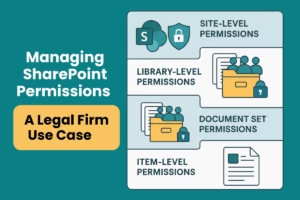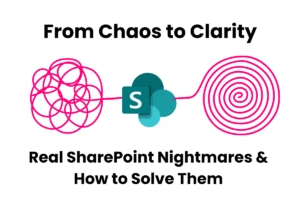Modern Information Architecture in SharePoint: A Practical Guide
If you’ve ever opened a SharePoint site and thought, “Where do I even start?” — you’re not alone. That’s where Information Architecture (IA) comes in.
In simple terms, Information Architecture is how we plan, organise, label, and connect information in SharePoint so people can find what they need easily, collaborate better, and manage content without it becoming a mess.
Getting your SharePoint IA right means:
- Clear, logical site structures that grow with your business
- Smart navigation that helps people, not confuses them
- Faster search results and less time spent hunting for documents
- A system that supports collaboration, governance, and real productivity
In SharePoint, a strong information architecture is the difference between a site that users love… and one they avoid.
How SharePoint Information Architecture Has Evolved
SharePoint has come a long way. The old approach relied on deep hierarchies with endless subsites and folders — great for file shares, but not ideal for a digital workplace.
Modern SharePoint flips this thinking:
Flat site structures (no more tangled subsites)
Hub sites to connect related sites while keeping them independent
Metadata and tagging instead of endless folders
Search-driven navigation that actually works
Responsive design for a better user experience across all devices
Today, it’s about making information easy to find — not forcing users through complicated site trees.
Core Elements of Modern SharePoint Information Architecture
Here is a look at the building blocks we focus on when setting up a great SharePoint environment.
🖥 Sites & Hub Sites
Modern SharePoint is built around flat, independent sites grouped together by hub sites.
Hubs bring everything together with consistent navigation, branding, and scoped search — making it easy for users to move across related content.
Tip: Always design with growth in mind. A flexible hub structure will save you major headaches later.
📚 Libraries & Lists
Libraries and lists are the workhorses of SharePoint — where your documents, data, and structured info live.
Good practice includes:
Creating purpose-specific libraries (not dumping everything in one place)
Using consistent naming conventions
Setting up views to match how users work
🏷 Metadata vs. Folders
In modern SharePoint, metadata rules.
Folders still have their place for simple organisation and permissions, but metadata gives you:
Smarter filtering
Cross-site discovery
Dynamic navigation
Flexible categorisation without endless folder clicks
Balanced Approach: Shallow folders + strong metadata = the best of both worlds.
📄 Content Types
Content types bundle settings like metadata, templates, workflows, and retention rules.
They help keep things consistent across different libraries and sites — saving time and reducing errors.
If you’re serious about governance and scaling, content types are a must.
🌐 Term Store & Managed Metadata
The term store lets you manage your company’s vocabulary and classification standards in one place.
With managed metadata, you get:
Consistent tagging
Better search results
Easier content management across multiple sites
Support for multilingual environments
📂 Functional Classification
Instead of organising by departments (which change all the time), we structure information by business function.
This approach is:
More stable
User-focused
Better aligned to how people actually work
Friendlier for compliance and records management
🔎 Search-Driven Architecture
Modern SharePoint leans heavily on search to help users find what they need.
That means planning things like:
Metadata optimisation for search
Custom search experiences
Search-driven web parts to surface important content
Promoted results to highlight critical links or resources
When you nail search, users stop browsing and start finding.









